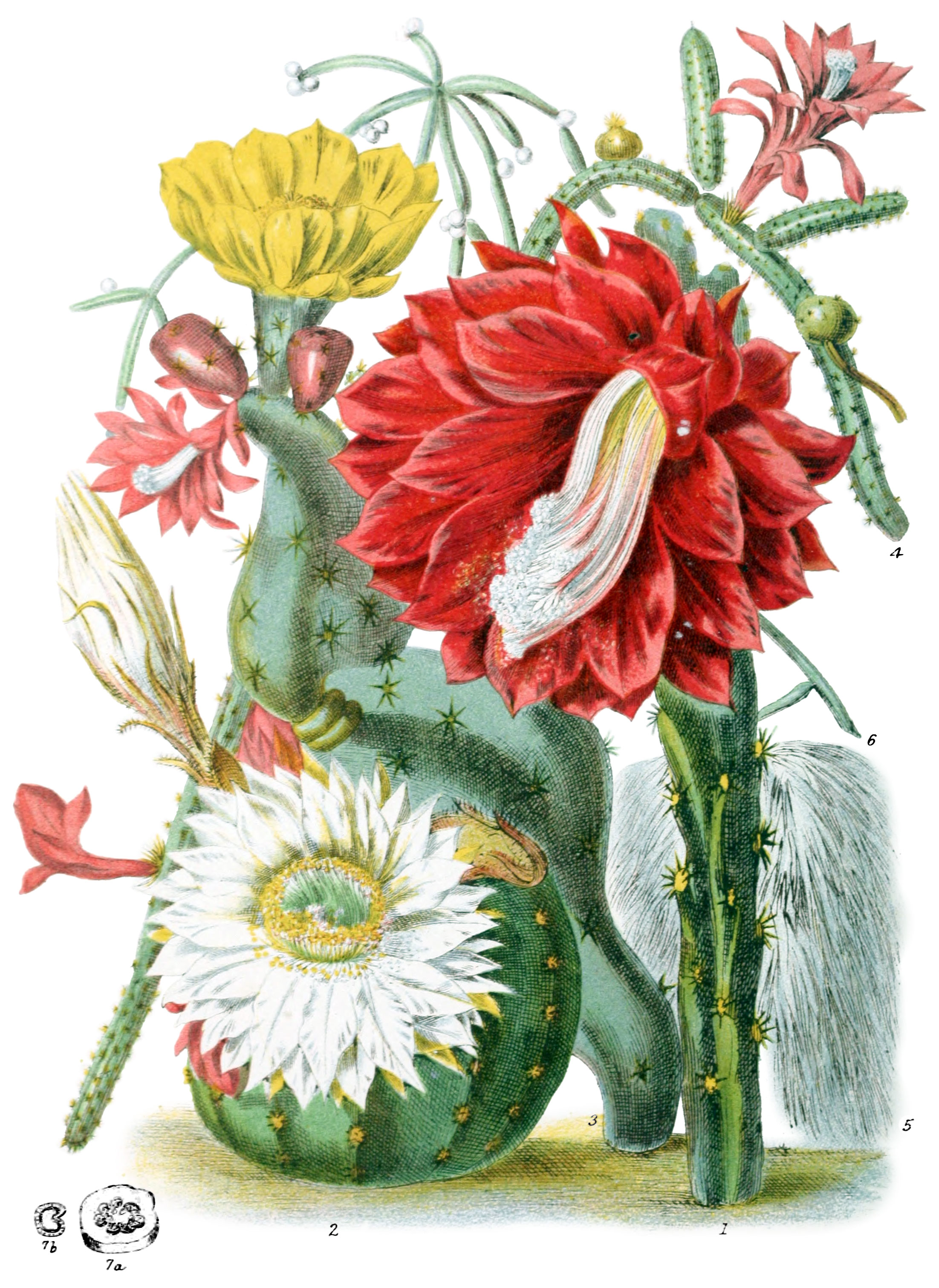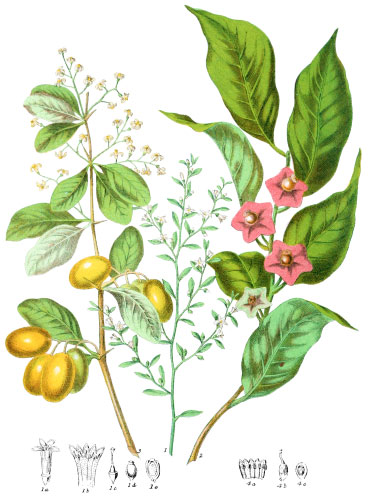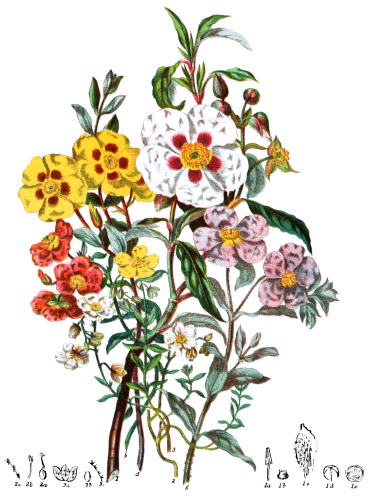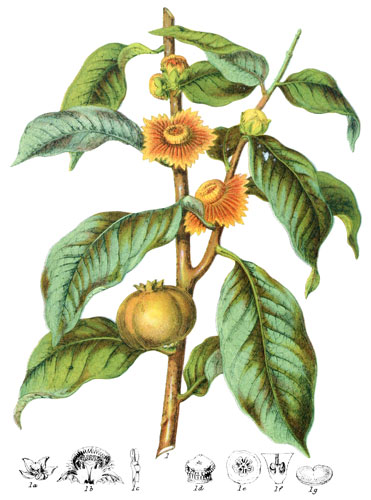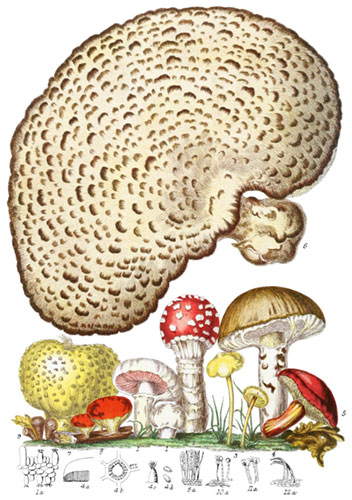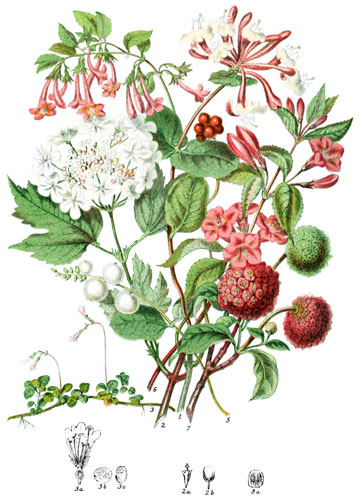Key characteristics
Succulent shrubs, very different in form. The stems are usually angular, or two-edged, or leafy; the wood is arranged wither in a ring of wedges, separated by pith, or it consists of fibres loosely interlacing, only forming into compact zones when old. Leaves almost always absent; if present, they are smooth, fleshy, entire; they most frequently exist only in the undeveloped form of spines. The flowers are of very short duration, the sepals numerous, gradually transofmred into petals, either crowning or covering the ovary; the petals are usually numerous, rising in two series from the orifice of the calyx. The stamens are of indefinite numbers, more or less cohering with the petals and sepals; the filaments are long and thread-like. The ovary is below, fleshy, one-celled, containing numerous ovules arranged on projections from the outer portion, equal in number to the lobes of the stigma; the style is long and slender, the stigmas many, collected into a cluster. The fruit is succulent, once-celled, many-seeded either smooth, or covered with scales or scars, or tubercles. The seeds have no albumen; when ripening, they become detached and embedded in pulp, which is invariably wholesome.
These plants have but little affinity with any others; they approach some Euphorbiaceæ in appearance, but are distinguished from them by their stellate instead of single spines, and by their vessels not giving out their fluid when cut.
The extreme distension of the cellular tissue is the striking character of the Tribe. It contains a vast store of moisture, which is not lost by evaporation, the cuticle being very thick, and destitute of perfect pores. Opuntia contains its cells flat and star-like crystals. The hairs are difficult of extraction if they enter the flesh, being barbed downwards.
Select plants in this order
Not all plants listed are illustrated and not all plants illustrated are listed.
- The Cactus, or Nopal Plants, were until lately scarecly seen in Europe; Linnæus knew but few of them. They are so abundant in America as to furnish a national emblem, one of the Mexican banners being an eagle on a Nopal plant. They exist in great variety of curious forms: some species are not larger than a walnut, others are many feet in circumference.
- Echinocactus visnaga is of enormous round shape. One plant brought in a cart drawn by several oxen, from the interior of Mexico, weighed upwards of 700lbs., and was beset with 8500 spines.
- In the parched soil, amid the ruins of the Azteck cities on the plains of Mexico, Pilocereus senilis rises in angular columns twenty or thirty feet in height, cothed with long grey hairs or spines, bearing no leaves, resembling the forms of architecture rather than those of the vegetable creation; long creeping stems of Cereus nycticallus wind amongst the stones.
- The round spiny Melon-cactus abounds in the hollows of rocks on the flowing pampas of Venezuela.
- Mammillaria and others ascend the lofty ranges of the Andes.
- A fleshy-leaved Pereskia, with its dark red-brown flowers, adorns the shores of Lake Titicaca, 12,700 feet above the sea.
- Vast patches of woolly Echinocactus, looking like sheep at a distance, inhabit the table-lands of Peru, at an elevation of 14,000 feet, on the verge of vegetable life.
- The larger species have solid wood in the interior; the door-posts of the loftiest habitation in the world, 12,600 feet high, at Antisana, on the Cordilleras, are made of columns of Cereus.
- Cereus speciosissimus (1) is one of the most beautiful species, the flowers in full light of the sun having a peculiarly brilliant appearance; the stamens and pistil are of very delicate construction, the minute grains of the pollen of the anthers descend the tube of the style a distance 1100 times greater than their own diameter, shooting out a thread slenderer than the finest cobweb, reaching the 30,000 ovules which line the ovary, and emabling them to become seeds.
- C. grandiflorus expands its large white and yellow flowers only in the evening; they are of extreme beauty and fragrance.
- Opuntia was early carried to Greece, and received its name from a tribe of the people; tuna is Arabic for fig, which the fruit resembles in shape.
- Opuntia tuna (3) is planted for hedges in Spain, and in crevices of lava around the base of Ætna; the roots, in growing, cause the lava to crack, and thus the barren ground is brought to fertility. The Sicilians esteem the fruit for its refreshing quality. In the West Indies and in Mexico, it is cultivated for the sake of the red dye obtained in a singular manner by the cochineal insect feeding on it; when the fruit is ripe it bursts open, and is found to be full of these little insects, which are then exposed to the sun to dry.
- O. cochinellifera yields a superior crimson, and is extensively grown in Brazil. It has lately been ascertained that the red colour can be extracted from the fruit, without the intervention of the little Coccus cacti.
- Rhipsalis pendula (6) is a remarkable plant, with flexible, leafless branches, bearing very delicate flowers and fruits at the joints.
- Epiphyllum has a combination of flat leaf and stalk, at the edge of which the flowers grow.
- Pereskia has flat, fleshy oval leaves, with spines at their ase, the leafy sepals remain on the globose fruit.
- P. aculeata, the Barbadoes gooseberry, bears numerous green and white flowers; the colourless pulp of the fruit has an agreeable flavour.
- When transplanted to Temperate climates, the fruit of this tribe is insipid, but in the tropics it is of considerable value to the men and animals; some fleshy species are eaten by cattle in Mexico, others afford the principal food of tortoises in the Gallapagos Isles.
Locations
America is the native region of this tribe, two species only being found in the East Indies. The chief station must be considered to be the torrid and subtropical zones of America, between 40° of lat. north and south of the equator. The Columbia River is the northern limit on the western coast of North America.
Legend
- Cereus speciosissimus, Beautiful Cactus. South America.
- Echinocactus Eyriesii, Sea-urchin Cactus. Mexico.
- Opuntia tuna, Indian Fig. South America.
- Cereus flagelliformis, Creeping Cereus. South America.*
- Pilocereus senilis, Old Man Cactus. South America.*
- Rhipsalis pendula, Drooping Rhipsalis. West Indies.
-
- Section of Fruit of Opuntia Dillenii.
- Section of Seed.
*4 was labeled as 5 and vice versa in the original legend.
Explore more
Posters
Decorate your walls with colorful detailed posters based on Elizabeth Twining’s beautiful two-volume set from 1868.
Puzzles
Challenge yourself or someone else to assemble a puzzle of all 160 botanical illustrations.
